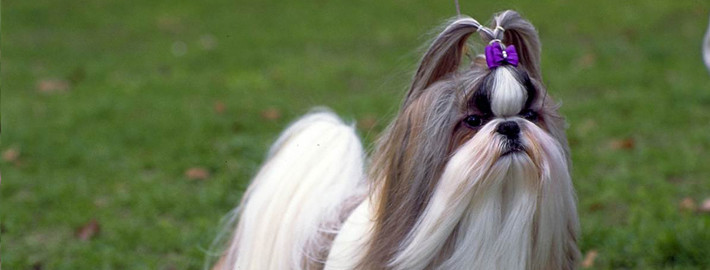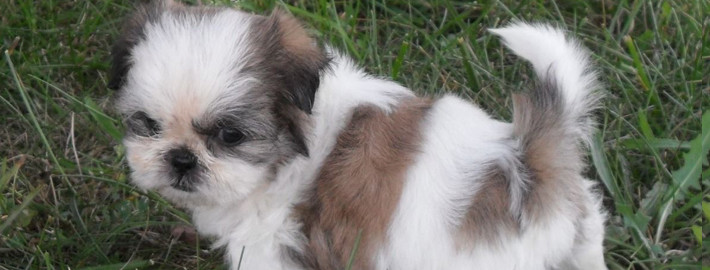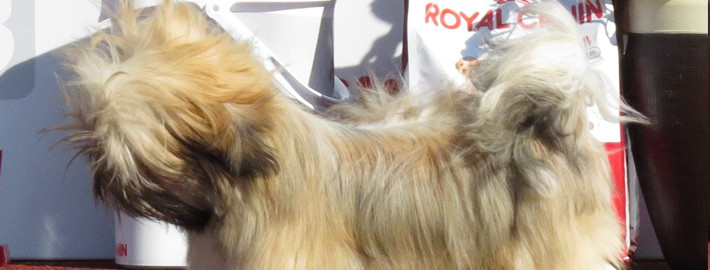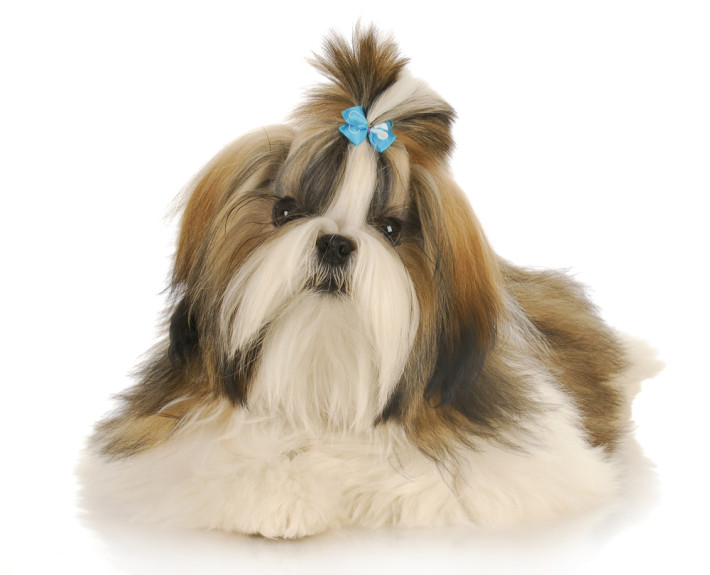What makes the Shih Tzu Unique?
Compact, yet slightly longer than it is tall, the Shih Tzu hides a sturdy body beneath its mantle of luxurious hair. It has a smooth, effortless stride with good reach and drive. Even though its function is that of companion, it should nonetheless be structurally sound. Its expression is warm, sweet and wide-eyed, imparting the impression of trust and friendliness. The long, dense coat is double and fairly straight. The spunky but sweet Shih Tzu is both a gentle lap dog and a vivacious companion. It has an upbeat attitude and loves to play and romp. It is affectionate to its family and good with children. It is surprisingly tough and does have a stubborn streak.
Breed Groups
Page Contents
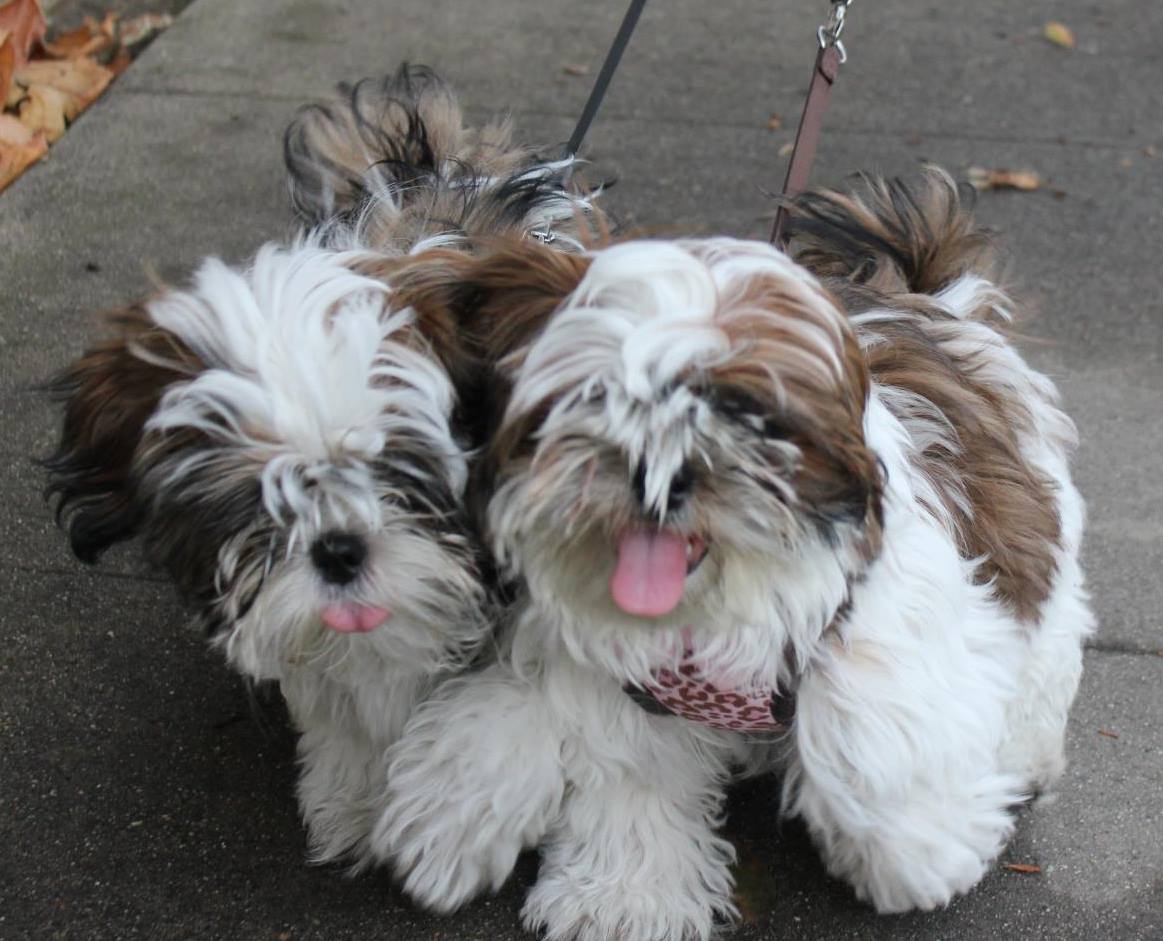
Is the Shih Tzu Right For You?
Carrying himself with a proud, arrogant bearing, yet possessing a happy, sweet-natured temperament, the Shih Tzu is less demanding and less happy than most other toy breeds. Most Shih Tzus are sweet-natured, yet also moderately stubborn and manipulative. You must show them, through absolute consistency, that you mean what you say. Food is a great motivator with Shih Tzus, but if you give too much you’ll end up with a fat Shih Tzu who listens to you only when you have a treat in your hand.
Though he is solidly built and lively and loves to play in the yard, he doesn’t need much more exercise than that. A lover of comfort and attention, he enjoys cuddling on laps and snuggling into soft pillows. He makes a terrific pet for senior citizens.
In 5 Words
- Lively
- Playful
- Gentle
- Outgoing
- Loyal
Characteristics
Learn About the Shih Tzu
Description
The Shih Tzu is a small, sturdy dog with a body that is slightly longer than it is tall. The head is round and broad, and wide between the eyes. The square muzzle is short, with an inch or less from the tip of the nose to the defined stop. The nose is broad, with well-open nostrils. Nose, lips and eye rims are liver on liver colored dogs, blue on blue dogs and black on all other colors. The teeth meet in a level or under bite. The large, round eyes are dark in color, but lighter on blue and liver dogs. The large, pendant, low-set ears hang down and are covered in abundant hair. The back is level. The muscular legs are straight and well-boned. The high-set tail is carried over the back and is covered in abundant hair. Dewclaws are sometimes removed. The double coat is dense and long, flowing down over the dog. The hair above the eyes is often tied in a topknot. There is a profuse beard and mustache and the hair on the muzzle is short. Coat comes in all colors.
Short History of the Shih
The name Shih Tzu Kou, or Shih Tzu, translates to “mini lion,” the moniker given to it in deference to its lion-like appearance. The name is likely based on the word for lion, “shishi.” The lion was highly esteemed in China for its connection with Buddhism, since it had a long tradition as guardian of the temples and palaces. The lion’s strength and courage was revered, and it made its way into many of Buddha’s teachings. This little dog was bred to reflect that appearance of strength, regality, and beauty, and it took the position as a practical stand in for the lion, acting as companion and guardian of the palace and temple.
It is probable that this dog was actually developed in Tibet in the 1600s, where it was considered a holy animal. It is accepted as one of the oldest dog breeds on record. The modern Shih Tzu developed in China in the late 19th Century, when the Dowager Empress Cixi ruled the kingdom.
Though the Pekingese and Shih Tzu breeds have similar backgrounds, and have often been linked over the years, the two had been long distinguished in Chinese art, where the latter is shown with a pien-ji or topknot, denoted by bumps on the head. It is worth remarking that the topknot is still the style that is used for the Shih Tzu, especially in the show ring.
When the Dowager Empress Cixi ruled during the latter part of the Qing dynasty, the Shih Tzu were held in great regard, and were kept as special house pets. She personally oversaw their breeding, and the eunuchs in charge of the palace breeding took great pride in producing the most beautiful and distinct dogs, interbreeding, without the Empress’ knowledge, within the groups of Pekingese and Pugs that were also a part of the palace kennel in order to achieve those ideal. Because the dogs were also regarded as protectors of the palace, the instinct for barking at strangers was undoubtedly honed during this time. In fact, the Shih Tzu is still a highly recommended watch dog because of its quick and vocal reaction to strangers. The Empress was very jealous over her dogs and was not wont to share them with foreign dignitaries or friends. Many of the Empress’ dogs were lost after her death, causing a big blow to the breed. Later, Shih Tzus were displayed in China as Tibetan Poodles or Lhassa Terriers.
In 1935, the breed was shown as the Lhassa Lion Dog, and it was then that it began to gain popularity on a wider scale. In England there was confusion between the Shih Tzu and the Lhasa Apso, but in 1934, after the Apso was displayed, the two breeds were split into their own distinct classes. It was then that the smaller dogs with the shorter-noses and wider-skulls from Peking were given the Shih Tzu name. Just one Pekingese outcrossing was allowed, in 1952, but this cross was not permitted again. The standards for the purity of the bloodline have been strictly upheld since. In the 1960s, the U.S. saw immense growth in the breed’s popularity, paving the way for recognition by the American Kennel Club in 1969. It is among the most lovable of the toy breeds, and its popularity as a domestic companion and show dog continues to rise.
Temperament
Although a Shih Tzu’s temperament varies from dog to dog, the breed has a personality and temperament that is loyal, affectionate, outgoing, and alert. Training and proper socializing must start at a young age for the Shih Tzu to obey basic commands. While the Shih Tzu is an excellent watch dog because of its alert and active nature, it was not specifically bred for this purpose. Unlike the Lhasa Apso, which was bred to be a sentinel dog that enjoys high perches and is wary of strangers, the Shih Tzu prefers to be close to its companions and will often offer strangers its affection. Due to its friendly nature, the Shih Tzu tends to interact well with other dogs and with children and adults. Shih Tzu dogs have been observed to get peevish if provoked, so an owner should be mindful when the dog is in the presence of children. Improper training can also result in nipping and biting. Shih Tzu dogs can also become needy and cry if not properly disciplined at the correct age. Shih Tzu make excellent house pets especially if one lives in an apartment or does not have a large garden as they require minimal exercise. Overall, they are friendly and outgoing companions.
Caring for Your Shih Tzu
General Health
They can have respiratory problems from Snoring, wheezing, or infection. They can be prone to Ear infections if not cleaned accordingly. Spinal disc disease is something to watch out for since they have such short legs and a long back. This breed can grow to be overweight if not taken care of. It is important to keep up with teeth cleaning in order to prevent periodontal disease.
The Shih Tzu makes an ideal dog for both city and country living. In the city these dogs become easily accustomed to the noises and apartment style living. They never feel more proud then when strutting on their leash through crowds of people. They are also at home romping in the country. Due to their size and need for companionship they should be kept as an inside dog.
Grooming & Bathing
Shih Tzu is a time-consuming endeavor. Daily brushing and combing is a must to remove tangles, and bathing is usually necessary once per week. Brushing must reach all the way down to the skin in order to properly prevent tangles and mats. Owners who do not show their Shih Tzu often opt to clip the hair short to avoid the constant upkeep. Clipped dogs require trims every six to eight weeks.
Check the ears on a weekly basis for signs of infection, irritation, or wax build up. Cleanse regularly with a veterinarian-approved cleanser and cotton ball. Brush the teeth at least once per week to prevent tartar buildup and gum disease. Small dogs are prone to dental problems later in life, so brushing more often is a good idea. Additionally, nails should be trimmed once per month if the dog does not wear the toenails down naturally./p>
Exercise & Training
The Shih Tzu needs a daily walk. Play will take care of a lot of its exercise needs, however, as with all breeds, play will not fulfill its primal instinct to walk. Dogs that do not get to go on daily walks are more likely to display behavior problems. They will also enjoy a good romp in a safe, open area off lead, such as a large, fenced-in yard. Do not overfeed this breed or it will quickly become fat. Like housebreaking, training should begin as soon as your Shih Tzu enters the new house. The training sessions should be short but frequent, for example, ten to fifteen minute periods three times a day. This breed can have a short attention span, which makes quick lessons a more enjoyable experience. They are a highly intelligent dog and can be stubborn at times. With patience and a fun atmosphere these dogs are easy to obedience-train. They respond well to praise and treats for rewards on doing a good job.

